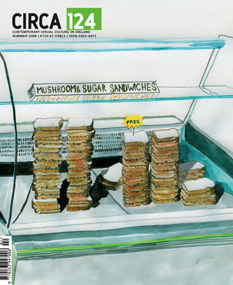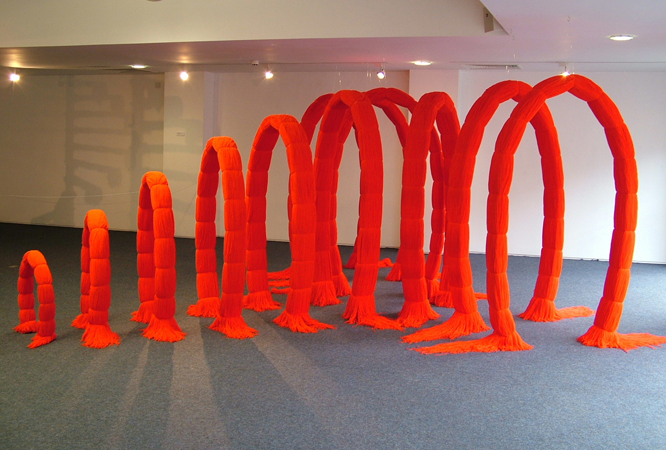|
|
"it's such a pleasure to welcome a real sculptor who has a deft, playful touch, as well as an over-active imagination." Brian McAvera SCULPTURE magazine, July/August 2009, published by The International Sculpture Center, New Jersey, USA
|
IN-BETWEEN (2008) Brendan Jamison, wool over wood, installation at Millennium Court Arts Centre, Portadown, RED TUNNEL, YELLOW SPIRAL STAIRCASE and BLUE BRIDGE. Detail installation view of JCB BUCKET SERIES (2008) Brendan Jamison, microcrystalline and paraffin wax over wood, 15 sculptures, dimensions ranging from 30 x 20 x 25 cms to 76 x 70 x 58 cms, Queen Street Studios Gallery, Belfast, Northern Ireland
Both concurrent exhibitions address the inertia of thinking and the stifling effect of majority-led culture and custom on liberty. [1] Brendan Jamison [2] has preferred the liberating qualities of non-traditional materials, including sugar cubes, wax and wool, gluing, cutting and pouring them into highly finished objects ever since his early work. [3] The new works share a valiant loyalty to primary colours and the desire to dislodge familiar function by segueing into play. Built specifically for the MCAC gallery, Yellow Spiral Staircase (2008) soars upwards, touching the sloped ceiling, as if documenting Kandinsky’s description of the physical effect of yellow as “shrill” and “high treble notes.” [4] Its wooden skeleton, partly transformed from hard wood to soft assembly of exactly measured lengths of wool, is decidedly an object to observe and touch and not one to climb. The ensuing relationship between the word, ie ‘staircase’, and the visible denial of reaching another space, allows reality to become continuous with imagination. The relationship between reality and mental acts has been long understood as constituent of ‘intentionality’. This has been variously defined as “immanent objectivity” (Franz Bretano, 1838-1917), as “consciousness” (Jean-Paul Sartre, 1905-1980) and as a sentient condition where an individual’s existentiality identifies with ontological significance as opposed to what is merely ontic [5] (Martin Heidegger, 1889-1976). Sentience is ability to make conscious choices including not doing, not talking, etc. [6] Jamison’s yellow sculpture engages us in the move from physical stance and design stance (mass, volume, verticality of the staircase) to the intentional stance [7] that activates beliefs, thinking, and crucially, the imagination. This process is intensified by scale, colour, material and position in space. The Apollonian faith in the necessity of order is embodied in the thirty-three-piece assembly that withstands the pull of gravity. As a sculpture it depends on ambivalence for a quality of antithetical referents. It approximates the form of which it speaks but, as Hegel put it, it remains essentially a question. The wool acts like cracks in the bark of the wood it covers, without unveiling its existence and history. The substitution of past by presence (ie the actual observer’s look, gaze, perception) and by future (ie the observer’s imagined purpose or function) could act as a wake-up call to a public obsessed with the past. Thus, the work enters the public domain as a question about the future. At Queen Street Studios Gallery, the JCB Bucket Series (2008) consisted of a gallery-floor display of fifteen different industrial models made from wood, covered with microcrystalline and paraffin wax in one of the primary or secondary colours. Familiar function was preserved in form but denied by material. The colour chimed with Kandinsky’s “colour is the keyboard, the eyes are the hammer and the soul is the piano.” [11] The installation became a jolly assembly of personages [12] dancing, jumping, biting, chatting, lying on the back, being pregnant, etc. Kandinsky [13] pointed to the power of children to clothe internal content into strong form. In reversal, Jamison took a strong form and clothed it in imagined animation. I cite Kandinsky because he faced squarely both the ontic presupposition of a work art and what Rubens called the “inner idea.” [14] At present ontology and epistemology are no longer kept apart due to innovations in quantum physics. In philosophy, Daniel Dennett worked out that the intentional stance is a level of abstraction in which we view the behaviour of a thing in terms of mental properties. A number of beliefs, thoughts and intents may be a theorist’s fiction, but operationally they are valid, throwing light on how art evokes a contingent truth that appears as a necessary one. RED TUNNEL (2008) Brendan Jamison, wool over wood, 12 components, 212 x 500 x 600 cms, installation at Millennium Court Arts Centre, Portadown.
[1] Inspired by J S Mill’s (1806-1873) defence of liberty
SVERAKOVA, SLAVKA. 'Brendan Jamison: In-Between & JCB Bucket Series' - CIRCA 124, Dublin, Summer 2008, pp. 85-87
Online Review: June 2008 Review by Declan McGonagle Installation view of JCB BUCKET SERIES (2008) Brendan Jamison, microcrystalline and paraffin wax over wood, 6 sculptures, Basement Gallery, Dundalk, Ireland. Curated by Fiona Mulholland for the exhibition The Space In Between, May 2008
Basement Gallery, Dundalk, May 2008 THE SPACE IN BETWEEN Curated by Fiona Mulholland
The Space in Between, therefore, is a synopsis, an ‘object’ lesson in contemporary sculptural concerns and practice that would stand wherever it were shown. The exhibition erases inherited categorisations across which the artists mark out their cross referencing propositions about negotiable process and space. Working from within their own practice and understandings of art and historical contexts, each artist has managed to speak in their own voice but also dialogue with other voices in the show. This is, of course, a measure of the curation and the capacity of the gallery context to test the art. In this period this process has to be an essential characteristic of publicly funded gallery/institutional provision, as we try to create new models of practice and reciprocal relations between artist and society. We have all eaten from the tree of knowledge and cannot go back to ‘Eden’ and this art reflects both the complexity of a new reality and our complicity in it. Declan McGonagle
McGONAGLE, DECLAN. “The Space In-Between: curated by Fiona Mulholland", CIRCA online, Dublin, June 2008
|
© Brendan Jamison 2008-2012 |




